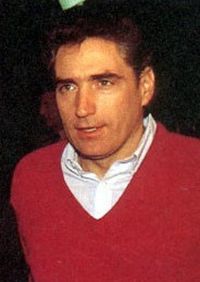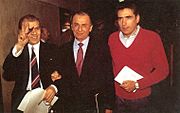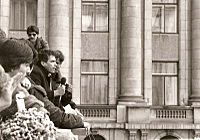Petre Roman facts for kids
Quick facts for kids
Petre Roman
|
|
|---|---|

Roman in 1989
|
|
| Prime Minister of Romania | |
| In office 26 December 1989 – 1 October 1991 Acting until 20 June 1990 |
|
| President | Ion Iliescu |
| Preceded by | Constantin Dăscălescu |
| Succeeded by | Theodor Stolojan |
| Member of the National Salvation Front Council | |
| In office 22 December 1989 – 26 December 1989 |
|
| President of the Senate of Romania | |
| In office 27 November 1996 – 22 December 1999 |
|
| Preceded by | Oliviu Gherman |
| Succeeded by | Mircea Ionescu Quintus |
| Minister of Foreign Affairs | |
| In office 22 December 1999 – 28 December 2000 |
|
| Prime Minister | Mugur Isărescu |
| Preceded by | Andrei Pleșu |
| Succeeded by | Mircea Geoană |
| Member of the Senate of Romania | |
| In office 22 November 1996 – 12 December 2004 |
|
| Member of the Chamber of Deputies | |
| In office 9 June 1990 – 31 July 1990 |
|
| In office 6 October 1992 – 21 November 1996 |
|
| In office 19 December 2012 – 9 February 2015 |
|
| Co-Founding Leader of the National Salvation Front | |
| In office 22 December 1989 – 28 May 1993 Serving with Ion Iliescu & Dumitru Mazilu
|
|
| Succeeded by | Himself (party renamed into the Democratic Party) |
| President of the Democratic Party | |
| In office 28 May 1993 – 19 May 2001 |
|
| Succeeded by | Traian Băsescu |
| President of the Democratic Force | |
| In office 2003–2008 |
|
| Personal details | |
| Born | 22 July 1946 Bucharest, Kingdom of Romania |
| Political party | Social Democratic Party (2020–present) |
| Other political affiliations |
Romanian Communist Party (before 1989) National Salvation Front (1989–1993) Democratic Party (1993–2003) Democratic Force (2003–2008) National Liberal Party (2008–2017?) Social Liberal Platform (2020) |
| Spouses |
Mioara Georgescu
(m. 1974–2007)Silvia Chifiriuc
(m. 2009) |
| Alma mater | Politehnica University of Bucharest Paul Sabatier University |
| Profession | Engineer |
| Known for | Romanian Revolution |
| Signature | |
| a. the party split on 7 April 1992: Ion Iliescu and his supporters formed the FDSN b. Mazilu resigned from the leadership of FSN on 26 January 1990 |
|
Petre Roman (born 22 July 1946) is a Romanian engineer and politician. He served as the Prime Minister of Romania from 1989 to 1991. He was also the president of the Senate from 1996 to 1999. Later, he became the Minister of Foreign Affairs from 1999 to 2000.
Mr. Roman was a leader of the Democratic Force (FD) party. He started this party after leaving the Democratic Party (PD) in 2003. He also served as a member of the Lower Chamber of Parliament. He was elected in 2012 as a member of the National Liberal Party. In 2020, he joined the Social Democratic Party. He was elected to the General Council of Bucharest but resigned shortly after.
In 2022, Petre Roman moved to Switzerland. He became the president of the Swiss UMEF, which is a university of applied sciences institute. He is also a member of the Club of Madrid. This group includes over 80 former democratic leaders who work to make democracy stronger around the world.
Contents
Early Life and Education
Petre Roman was born in Bucharest, the capital city of Romania. His father, Valter Roman, was a veteran of the Spanish Civil War. His mother, Hortensia Vallejo, was from Spain. She later directed the Spanish section of Radio Romania International.
Petre Roman went to the Petru Groza High School in Bucharest. He studied to become an engineer. He attended the Politehnica University of Bucharest and also the Paul Sabatier University in France.
Role in the Romanian Revolution
Petre Roman became well-known during the Romanian Revolution in 1989. This was a time when people in Romania stood up against the old government. He was part of the crowd that took over the National Television building. From there, he helped broadcast messages about the revolution's success.
On 22 December 1989, Petre Roman spoke to the public from a balcony. This was a very important moment. He spoke against the old government, showing his support for the revolution.
He became a member of the Provisional Council of the National Salvation Front (CPFSN). This group helped guide the revolution and set up a new democratic government.
Becoming Prime Minister

On 26 December 1989, Petre Roman was chosen as the temporary Prime Minister of Romania. This was for the new government formed by the FSN.
In May 1990, Romania held its first free elections in 53 years. Petre Roman was elected as a representative for Bucharest. After the elections, President Iliescu again named him Prime Minister on 20 June 1990. The new Parliament officially approved him on 28 June 1990.
He led three different governments between 1989 and 1991. These were known as the Roman I, Roman II, and Roman III cabinets. His time as Prime Minister ended in October 1991.
Political Career and Elections
After his time as Prime Minister, Petre Roman continued to be active in Romanian politics. He led different political parties over the years. He was the president of the Democratic Party from 1993 to 2001. Later, he founded and led the Democratic Force party.
He ran for president in several elections. Here is a look at his results:
| Election | Affiliation | First round | Second round | ||||
|---|---|---|---|---|---|---|---|
| Votes | Percentage | Position | Votes | Percentage | Position | ||
| 1996 | USD | 2,598,545 |
20.53%
|
3rd | not qualified | ||
| 2000 | PD | 334,852 |
2.98%
|
6th | not qualified | ||
| 2004 | FD | 140,702 |
1.34%
|
7th | not qualified | ||
See also
 In Spanish: Petre Roman para niños
In Spanish: Petre Roman para niños


